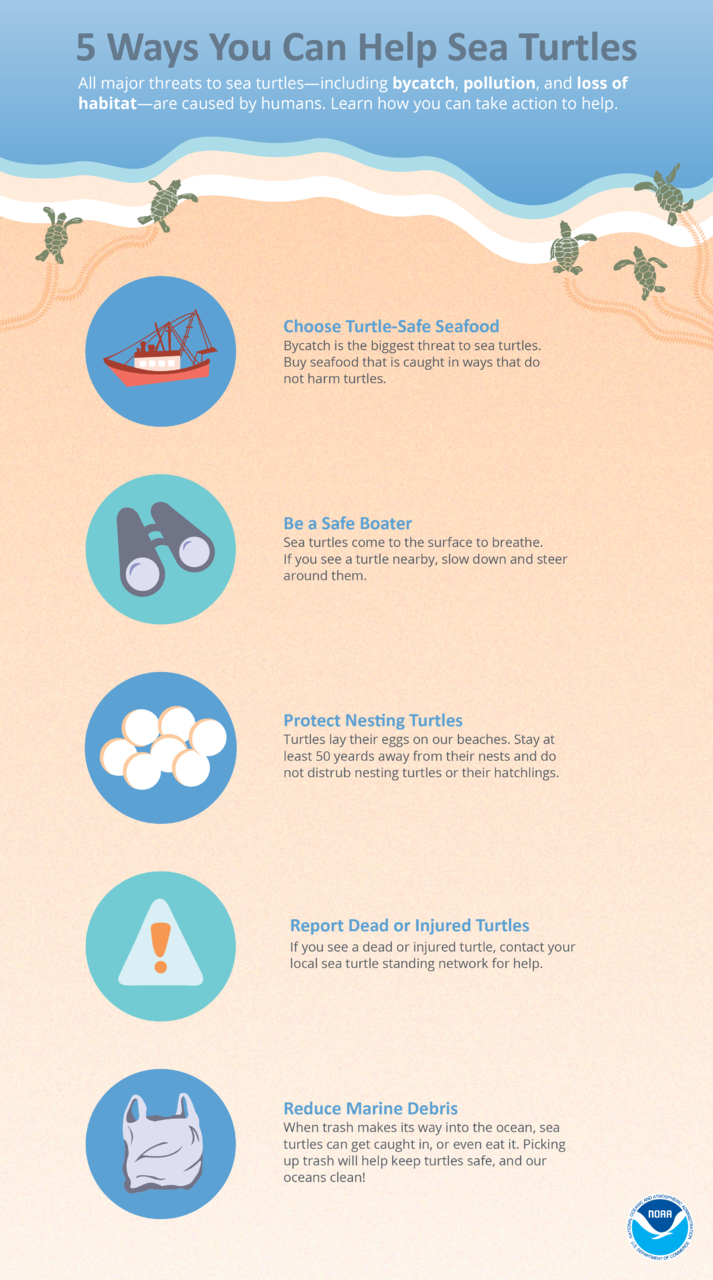World Sea Turtle Day is June 16. Join us for Sea Turtle Week, June 10-16, 2019, to celebrate these spectacular marine animals. Sea turtles, also called marine turtles, are air-breathing reptiles with streamlined bodies and large flippers. Well-adapted to life in the marine environment, they inhabit tropical and subtropical ocean waters throughout the world.

Although sea turtles live most of their lives in the ocean, adult females must return to beaches on land to lay their eggs. They often migrate long distances between feeding grounds and nesting beaches. Seven species have been identified worldwide. Six sea turtle species are found in U.S. waters (the flatback sea turtle is found only in Australia and Papua New Guinea).
NOAA Fisheries works with our partners to improve the conservation and recovery of threatened and endangered sea turtles. This #SeaTurtleWeek, we highlight how we use science to help save sea turtles.
Sea Turtle Videos
Go Slow: Sea Turtles Below
Watch the video below to see how Dr. Brian Stacy studies sea turtle health, welfare, and mortality. Learn how to help reduce vessel strikes while on the water.
WARNING: This video contains images of injured turtles and internal anatomy.
Reducing Bycatch Helps Restore Sea Turtle Populations
Watch this video to learn about a project that is helping reduce sea turtle bycatch and restore their populations after the Deepwater Horizon oil spill. Bycatch—when animals are accidentally caught while people are fishing for other species—is the biggest threat to sea turtles in the ocean. Two new monitoring teams are working closely with fishermen to ensure that their turtle excluder devices are installed properly.
Sea Turtle Features
A Continuation of Motherload: The Story of a Fertile Turtle in the Hawaiian Islands
This past March, researchers with NOAA's Marine Turtle Biology and Assessment Program located a fertile female Hawaiian green sea turtle using ultrasound, and put a satellite tag on her to see where she would migrate to lay her eggs. This is the continuation of her story.
Learn more about Motherload's journey

5 Ways You Can Help Sea Turtles
All major threats to sea turtles—including bycatch, pollution, and loss of habitat—are caused by humans. Check out this infographic to learn how you can help keep sea turtles safe.

Scientists study sea turtle “fingerprints” to gather clues about their life history, mating strategies, and family groups.
Learn more about their work studying sea turtle DNA

Celebrating Sea Turtle Week 2019
Every day, NOAA scientists and resource managers collaborate with partners across the globe to conserve and recover protected species as part of our mission. Sea turtle conservation activities have been a hallmark of those efforts.

A Brighter Future for Sea Turtles
Scientists are testing nets illuminated with LED lights to see if increasing net visibility reduces sea turtle bycatch in gillnet fisheries.
See how the use of illuminated gillnets could prove beneficial for both sea turtles and fishermen

Turtle Tweet Chat: Dive Deeper into Sea Turtle Biology, Science, and Conservation
Ask questions about sea turtles and learn more about our work to conserve them during a tweet chat on June 12, 2019.
Find details on our upcoming turtle tweet chat

Pilots Help Turtles Take Flight
Private pilots volunteer to help transport sick turtles from the Northeast to rehabilitation hospitals along the Atlantic and Gulf coasts.

Motherload: The Story of a Fertile Turtle in the Hawaiian Islands
Researchers track a female green sea turtle's nesting journey after a hurricane washes away an important nesting beach.
Learn more about how researchers are tracking the sea turtle nicknamed "Motherload"
Learn what actions you can take to help save sea turtle, including how you can protect sea turtle habitat and tips for sea turtle friendly fishing and boating tips.
Learn more about what you can do to help conserve sea turtles





